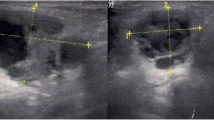Summary
Three parotid tumors, in a 45-year-old woman, a 41-year-old woman and a 28-year-old man, are described. The surrounding tumor-free parotid parenchyma contained heterotopic free sebaceous glands in varying quantities. Their probable course of development: individual sebaceous cell—sebaceous-gland bud—mature sebaceous gland, is presented. The first case involved a pleomorphic adenoma (so-called mixed tumor) with (tumor induced?) hypertrophy of the sebaceous glands on the outside resembling the “senile” sebaceous-gland nevi of the skin, and centrally extensive transition to sebaceous gland carcinoma and in some places, to parakeratotic squamous cell carcinoma. The second case involved a small, partly solid and partly small-glandular adenoma containing occasional individual cells resembling sebaceous cells. The third case was classified as a pure sebaceous-gland carcinoma of the parotid. The significance of the holocrine elements for the tumor event is emphasized, particularly with regard to the widening of the morphological spectrum of the parotid adenoma through individual sebaceous-like cells, structures resembling sebaceous glands and carcinomas with structures similar to sebaceous glands. Pure sebaceous-gland carcinoma can also readily be derived from parotid sebaceous elements.
Zusammenfassung
Es wird über drei Parotisgeschwülste bei einer 45jährigen Frau, 41jährigen Frau und einem 28jährigen Mann berichtet, deren umgebendes tumorfreies Parotisparenchym heterotope freie Talgdrüsen in wechselnder Menge enthält. Ihr vermutlicher Entwicklungsgang: Einzeltalgzelle — Talgdrüsenknospe — reife Talgdrüse wird aufgezeigt.
Im 1. Fall liegt ein pleomorphes Adenom (sog. Mischgeschwulst) vor, am Rande mit (tumorinduzierter?) Hypertrophie von Talgdrüsen ähnlich den „senilen“ Talgdrüsennaevi der Haut, zentral mit ausgedehntem Übergang in Talgdrüsencarcinom, streckenweise auch in parakeratorisch verhornendes Plattenepithelcarcinom.
Beim 2. Fall liegt ein kleines, teils solides, teils kleindrüsiges Adenom vor, das gelegentlich talgzellenähnliche Einzelzellen enthält.
Der 3. Fall wird als reines Talgdrüsencarcinom der Parotis aufgefaßt.
Die Bedeutung der holokrinen Elemente für das Tumorgeschehen, insbesonders hinsichtlich der Erweiterung des morphologischen Spektrums der Parotisadenome durch talgzellenartige Einzelzellen, talgdrüsenartige Strukturen und Carcinome mit talgdrüsenartigem Bau wird unterstrichen.
Reine Talgdrüsencarcinome lassen sich gleichfalls zwanglos von den Talgelementen der Parotis ableiten.
Similar content being viewed by others
Literatur
Barton, R. T.: Lymphoepithelial tumors of the salivary gland. With case report of sebaceous lymphadenoma. Amer. Surg. 30, 411–414 (1964).
Cheek, R., Pitcock, J. A.: Sebaceous lesion of the parotid. Arch. Path. 82, 147–150 (1966).
Evans, R. W.: Histological appearences of tumours, 2. ed. Edinburgh-London: E. u. S. Living-stone 1968.
Evans, R. W., Cruickshank, A. H.: Epithelial tumours of the salivary glands. Philadelphia-London-Toronto: W. B. Saunders Co. 1970.
Feyrter, F.: Die peripheren endokrinen (parakrinen) Drüsen in Kaufmann-Staemmler, Lehrbuch der speziellen Pathologischen Anatomie. Erg. Bd. I, 1. Hälfte, 4. Lieferung. Berlin: Walter de Gruyter u. Co. 1969.
Foote, F. W.: Seminar on disease of the maxillo-facial region, including salivary glands, case 5. Proc. 26. Seminar of the American Society of Clinical Pathology, Sept. 30, 1960.
Foote F. W., Frazell, E. L.: Tumors of the maior salivary glands. Atlas of tumor pathology, section IV, fasc. 11. Washington D. C.: Armed Forces Institute of Pathology 1954.
Geiler, G.: Zur Pathogenese der Adenolymphome. Arch. Path. 330, 172–191 (1957).
Hamperl, H.: Beiträge zur normalen und pathologischen Histologie menschlicher Speicheldrüsen. Z. mikr.-anat. Forsch. 27, II. Teil, 1–55 (1931).
Hartz, Ph. H.: Development of sebaceous glands from intralobular ducts of the parotid gland. Arch. Path. 41, 651–654 (1946).
Harvey, W. F., Dawson, E. K., Innes, J. R. M.: Debatable tumours in human and animal pathology, p. 24, fig. 25. London: Oliver & Boyd Ltd. 1940
Kleinsasser, O.: Über das Sebazeolymphom der Parotis. Mschr. Ohrenheilk. 98, 318–325 (1964).
Kleinsasser, O., Hübner, G., Klein, H. J.: Talgzellencarcinom der Parotis. Arch. klin. exp. Ohr.-Nas.- u. Kehlk.-Heilk. 197, 59–71 (1970).
Lee, M. C.: Intraparotid sebaceous glands. Ann. Surg. 129, 152–155 (1949).
Lever, H. F.: Histopathology of the skin, 4. ed. London: Pitman Medical Publishing Co., Ltd. Philadelphia: J. B. Lipincott Co. 1967.
Lucas, R. B.: Pathology of tumours of the oral tissues, 2nd ed. Edinburgh-London: Churcill-Livingstone 1972.
Mathis, H.: Beitrag zur Kenntnis der Sialome. Ein vertalgendes Carcinom der Glandula parotis. Dtsch. Zahn.-, Mund- u. Kieferheilk. 50, 405–408 (1968).
McGavran, M. H., Bauer, W. C., Ackermann, L. V.: Sebaceous lymphadenoma of the parotid salivary gland. Cancer (Philad.) 13, 1185–1187 (1960).
Meza-Chavez, L.: Oxyphilic granular cell adenoma of the parotid gland (Oncocytoma). Amer. J. Path. 25, 523–548 (1949).
Meza-Chavez, L.: Sebaceous glands in normal and neoplastic parotid glands. Amer. J. Path. 25, 627–645 (1949).
Patey, D. H., Thackray, A. C.: The treatment of parotid tumours in the light of a pathological study of parotidectomy material. Brit. J. Surg. 45, 477–487 (1958).
Plessis, du, D. J.: Some important features in the development structure and function of the parotid salivary glands. S. Afr. med. J. 31, 773–780 (1957).
Rauch, S., Masshoff, W.: Die talgdrüsenähnlichen Sialome. Frankfurt. Z. Path. 69, 513–525 (1959).
Rawson, A. J., Horn, R. C.: Sebaceous glands and sebaceous gland-containing tumors of the parotid salivary gland. Surgery 27, 93–101 (1950).
Seifert, G.: Mundhöhle, Mundspeicheldrüsen, Tonsillen und Rachen. In: Doerr-Uehlinger, Spezielle Pathologische Anatomie, Bd. I, Berlin-Heidelberg-New York: Springer 1966.
Seifert, G., Geiler, G.: Zur Pathologie der kindlichen Kopfspeicheldrüsen. Beitr. path. Anat. 116, 1–38 (1956).
Silver, H., Goldstein, M. A.: Sebaceous cell carcinoma of the parotid region. Cancer (Philad.) 19, 1773–1779 (1966).
Tsukada, Y., de la Pava, S., Pickren, J. W.: Sebaceous-cell carcinoma arising in mixed tumor of parotid salivary gland. Oral Surg. 18, 517–522 (1964).
Wuketich, St., Kittinger, G.: Lymphadenoma sebaceum der Parotis. Arch. klin. exp. Ohr.-, Nas.- u. Kehlk.-Heilk. 187, 836–844 (1966).
Author information
Authors and Affiliations
Rights and permissions
About this article
Cite this article
Schmid, K.O., Albrich, W. Die Bedeutung von Talgzellen und Talgdrüsen für Parotisgeschwülste. Virchows Arch. Abt. A Path. Anat. 359, 239–253 (1973). https://doi.org/10.1007/BF00550043
Received:
Issue Date:
DOI: https://doi.org/10.1007/BF00550043




